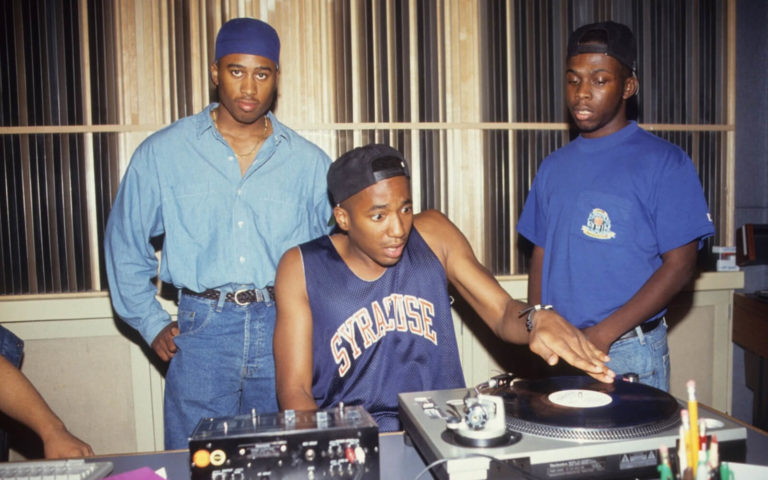By Megan Magdalena
Two decades after a life-changing concert, Megan Magdalena walks through the Sum 41 exhibition—this time as a music photographer alongside the band that started it all.

Twenty-five years ago, on July 30, 1996, A Tribe Called Quest dropped Beats, Rhymes and Life, their aptly named fourth studio album. Its title, so precise to describe the group’s sound, also succinctly encapsulated hip-hop into three words. As the successor to their back-to-back revered hip-hop classics — The Low End Theory (1991) and Midnight Marauders (1993) — Beats, Rhymes & Life remains an understated and iconic hip-hop record; an album that, despite surfacing amid rap’s regional rivalry, lived in its own colourful world.
ATCQ’s story is a story of unity: unity between jazz and rap, unity between rhythm and rhymes, and unity between two friends — Kamaal Fareed, known professionally as Q-Tip, and the late Malik Taylor, aka Phife Dawg. According to hip-hop lore, they met as infants. Years later, they would be the founders of one of hip-hop’s most innovative collectives: A Tribe Called Quest.
Born in the late 80s in Queens, ATCQ pioneered hip-hop’s Afrocentric movement, a worldview which exalted traditional African values by infusing hip-hop with funk and jazz while revamping old breaks into contagious head-nodding beats. The group consisted of producer Q-Tip, a business-minded sample genius and beat-making professor; his childhood friend and emcee Phife Dawg, the late-great five-foot-assassin who broke through microphones; and their wingman Ali Shaheed Muhammad, the Gemini rapper, mixer, DJ, producer and designed mediator. A fourth member, Jarobi White, participated in two albums.
Together, ATCQ released six LPs — from their debut, People’s Instinctive Travels and the Paths of Rhythm (1990), to their last album, We got it from Here… Thank You 4 Your service (2016), released months after Phife’s untimely death from health complications. Their records shaped jazz-rap and East Coast hip-hop like few other records ever did. The Source magazine, an authoritative voice in hip-hop criticism, gave two of these albums their highest possible rating: five mics.
When Tribe released Beats, Rhymes and Life on Jive in July 1996, the stakes were high. The group was used to critical acclaim, and hip-hop’s East-West rivalry was sizzling. Hip-hop heads know the story: in the mid-1990s, the hip-hop scene was full of animosity between the East Coast and West Coast. Nas, Puff Daddy, and Biggie against Snoop Dogg, Dr. Dre and Tupac. To this backdrop, ATCQ chipped in with elegance. Beats, Rhymes and Life kicks off with Q-Tip calling out the posers on “Phony Rappers.” According to Tip, everyone wanted to jump on the hip-hop train, but few could write great poetry and then rap it. Q-Tip flipped a sample from the vocal soul band The Emotions’ “Blind Alley” to create the diss track — courtesy of his crate-digging instincts.
The track’s message is what makes it so prophetic. Released at the height of rap’s coastal rivalry, “Phony Rappers” remains a classy example of a diss track. Instead of firing off death threats to West Coast emcees, Tip and Phife tell the story of a spontaneous rap battle happening in a NYC subway station — and how they humiliate their rival with their unmatched skills. It’s a deftly rapped episode, an almost quaint effort compared to famous diss tracks such as 2Pac’s “Hit ‘Em Up.” Tribe, then again, never fronted their act like a bunch of gat-carrying gangstas — that was not their beat.
The album’s liner notes underscore ATCQ’s strive for unity: production is credited to “the Ummah,” a production unit composed of Q-Tip, Ali Shaheed Muhammad, and the newcomer mixing genius J Dilla, maybe Q-Tip’s most salient pupil. Farther into Beats, Rhymes and Life, on the song “Keep It Moving,” Q-Tip responds to the ongoing wars by showing that he was just too skilled to engage in a low-grade conflict: “I could never diss a whole coast, my time is too great / Yeah, we from the East, the land of originators / you also from the West, the land of innovators / The only difference of the two is the style of the rap,” he explains.
As with every other Tribe release, Beats, Rhymes and Life offered plenty of double entendres, intelligent wordplay, braggadocio confidence, and smooth sexuality. It’s also Tribe’s darkest record — a deviation from their light-hearted classics. For example, in “Mind Power,” Tip references Mobb Deep’s classic album The Infamous (1995) — New York City’s definitive rapping document on the hardships of the city’s underworld. In their single “1nce Again,” the band (and J Dilla) snatch a Cannonball Adderley sample to create a union between hard bop and hip-hop — the closest the group ever got to the boom-bap sound.
Despite its dark tinges, Beats, Rhymes and Life is explicit about A Tribe Called Quest’s pursuit for unity. On “The Hop,” the group asks their fans to join them: “A-yo, inside the ghetto or in a sunny meadow / I’ma make you move, whether woman or fellow.” This is quintessentially Tribe, bringing up rhythms to link people up. Lyrics and sounds, we already know, are capable of rallying people together after racially driven traumas. A quarter-century after Tribe dropped their fourth album, its power remains untouched. Beats, Rhymes & Life continues to revolutionize humanity through acoustic harmony.
By Megan Magdalena
Two decades after a life-changing concert, Megan Magdalena walks through the Sum 41 exhibition—this time as a music photographer alongside the band that started it all.
By Cam Delisle
Nine albums in, Something Beautiful finds the icon at her most reflective—and most free.
By By Brad Simm
The Edmonton punk band teeter on chaos and clarity with the release of their new single from upcoming album, Skinning.